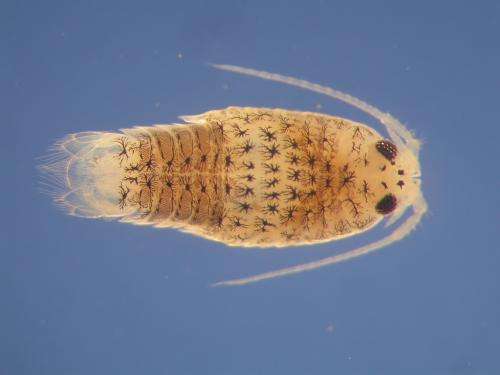Credit: Prifysgol Aberystwyth University
The diminutive speckled sea louse (Eurydice pulchra) boasts two body clocks, one for night and day and another for the ebb and flow of the tide, according to research published today.
Writing in the journal Current Biology, researchers from Aberystwyth, Bangor, Cambridge and Leicester Universities have confirmed the existence for the first time of a distinct and independent circatidal body clock that follows the 12.4 hour cycle of the tide.
All organisms from simple bacteria to humans have the ability to tell the time using so-called body clocks.
On land and in the air the body clocks of humans, as with most land-dwelling organisms, are synchronized by the light and dark cycles – the circadian cycle.
This is the reason why people experience jet-lag when travelling over several time-zones; their internal clocks are out of kilter with the day/night cycle of the new destination.
However, in the sea, and particularly on the shore, organisms are challenged not only by 24 hour light cycles but also by other regular changes in the environment, the most noticeable of which are the tides that occur every 12.4 hours.
The researchers have been studying the behaviour of the speckled sea louse, examples of which were collected from a beach near Bangor in north Wales.
A marine cousin of the wood-louse, the speckled sea louse is commonly found on sandy beaches along the coasts of western Europe.
Measuring up to 5mm in length, it burrows deep into the sand when the tide goes out and returns to the surface to swim and feed when the tide comes in.
During the day it turns dark in colour to protect itself from UV light. At night it turns white and swims far more vigorously.
This is a Eurydice crustacean swimming. Credit: Zhang et al., Current Biology
By using genetic, pharmacological and in vitro cell biology techniques and providing continuous light under laboratory conditions, the researchers were able to switch off the circadian clock.
Despite this, and being removed from its natural environment, the speckled sea louse continued to swim every 12.4 hours for many days.
This, the researchers argue, provides incontrovertible evidence that the speckled sea louse possesses two separate and independent body clocks, the circadian which follows the night and day cycle, and the tidal clock which runs on a 12.4 hour cycle.
Senior author on the research, Dr David Wilcockson, is an aquatic biologist at the Institute of Biological, Environmental and Rural Sciences at Aberystwyth University.
Dr Wilcockson said; "Humans are geared to anticipate the daily cycles of light and dark and in general we coordinate our behaviour and physiology to correspond with wake and sleep cycles.
"We know that we have special timing cells deep in our brains that keep us to a tight 24h schedule, even when we are removed from the natural environment, such as in sub mariners. This is extremely important to our well-being and we know that faulty clocks in humans may lead to serious medical conditions ranging from cancer to mental health disorders.
"Whilst we know a tremendous amount about circadian clocks in the brains of mammals we know very little about the clocks in marine animals that drive the biological processes associated with tides.
"The discovery of the circadian clock mechanisms in various terrestrial species from fungi to humans was a major breakthrough for biology. The identification of the tidal clock as a separate mechanism now presents us with an exciting new perspective on how organisms define biological time. It is a completely unexplored field.
"Given the diversity of marine species, there is every reason to expect many surprises in the composition of the clocks they use and how they use them.
"It is important that we explain the molecular and cellular mechanism of these tidal clocks for a number of reasons.
"Firstly, the speckled sea-louse evolved many millions of years before mammals and represents a simplified model system that we can use to help understand the clocks of more complex animals.
"Secondly, a deeper appreciation of rhythms in marine organisms could have implications for the welfare and productivity of cultured marine species and our understanding of the behaviour of commercially important ones.
Dr Wilcockson and his collaborators believe that unrelated species that inhabit the same environment may also have evolved a similar solution to the same problems.
"There is tremendous diversity in the oceans and biology is so inventive that it may have come up with many different solutions exploiting various mechanisms to solve the same challenges of life.
"Our work has revealed that evolution created a greater diversity of clock types than we ever thought previously, so we really are on the threshold of some exciting science", he added.
More information: The paper, Dissociation of Circadian and Circatidal Timekeeping in Marine Crustacean Eurydice pulchra is published in Current Biology. dx.doi.org/10.1016/j.cub.2013.08.038
Journal information: Current Biology
Provided by Prifysgol Aberystwyth University




















